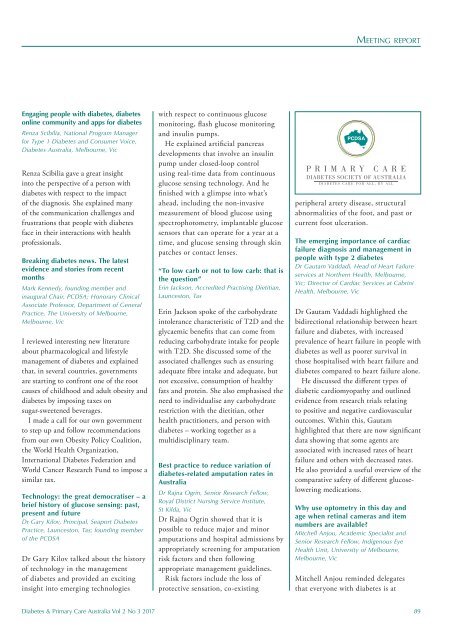DPCA 2-3_entire_v3
Create successful ePaper yourself
Turn your PDF publications into a flip-book with our unique Google optimized e-Paper software.
Meeting report<br />
Engaging people with diabetes, diabetes<br />
online community and apps for diabetes<br />
Renza Scibilia, National Program Manager<br />
for Type 1 Diabetes and Consumer Voice,<br />
Diabetes Australia, Melbourne, Vic<br />
Renza Scibilia gave a great insight<br />
into the perspective of a person with<br />
diabetes with respect to the impact<br />
of the diagnosis. She explained many<br />
of the communication challenges and<br />
frustrations that people with diabetes<br />
face in their interactions with health<br />
professionals.<br />
Breaking diabetes news. The latest<br />
evidence and stories from recent<br />
months<br />
Mark Kennedy, founding member and<br />
inaugural Chair, PCDSA; Honorary Clinical<br />
Associate Professor, Department of General<br />
Practice, The University of Melbourne,<br />
Melbourne, Vic<br />
I reviewed interesting new literature<br />
about pharmacological and lifestyle<br />
management of diabetes and explained<br />
that, in several countries, governments<br />
are starting to confront one of the root<br />
causes of childhood and adult obesity and<br />
diabetes by imposing taxes on<br />
sugar-sweetened beverages.<br />
I made a call for our own government<br />
to step up and follow recommendations<br />
from our own Obesity Policy Coalition,<br />
the World Health Organization,<br />
International Diabetes Federation and<br />
World Cancer Research Fund to impose a<br />
similar tax.<br />
Technology: the great democratiser – a<br />
brief history of glucose sensing: past,<br />
present and future<br />
Dr Gary Kilov, Principal, Seaport Diabetes<br />
Practice, Launceston, Tas; founding member<br />
of the PCDSA<br />
Dr Gary Kilov talked about the history<br />
of technology in the management<br />
of diabetes and provided an exciting<br />
insight into emerging technologies<br />
with respect to continuous glucose<br />
monitoring, flash glucose monitoring<br />
and insulin pumps.<br />
He explained artificial pancreas<br />
developments that involve an insulin<br />
pump under closed-loop control<br />
using real-time data from continuous<br />
glucose sensing technology. And he<br />
finished with a glimpse into what’s<br />
ahead, including the non-invasive<br />
measurement of blood glucose using<br />
spectrophotometry, implantable glucose<br />
sensors that can operate for a year at a<br />
time, and glucose sensing through skin<br />
patches or contact lenses.<br />
“To low carb or not to low carb: that is<br />
the question”<br />
Erin Jackson, Accredited Practising Dietitian,<br />
Launceston, Tas<br />
Erin Jackson spoke of the carbohydrate<br />
intolerance characteristic of T2D and the<br />
glycaemic benefits that can come from<br />
reducing carbohydrate intake for people<br />
with T2D. She discussed some of the<br />
associated challenges such as ensuring<br />
adequate fibre intake and adequate, but<br />
not excessive, consumption of healthy<br />
fats and protein. She also emphasised the<br />
need to individualise any carbohydrate<br />
restriction with the dietitian, other<br />
health practitioners, and person with<br />
diabetes – working together as a<br />
multidisciplinary team.<br />
Best practice to reduce variation of<br />
diabetes-related amputation rates in<br />
Australia<br />
Dr Rajna Ogrin, Senior Research Fellow,<br />
Royal District Nursing Service Institute,<br />
St Kilda, Vic<br />
Dr Rajna Ogrin showed that it is<br />
possible to reduce major and minor<br />
amputations and hospital admissions by<br />
appropriately screening for amputation<br />
risk factors and then following<br />
appropriate management guidelines.<br />
Risk factors include the loss of<br />
protective sensation, co-existing<br />
peripheral artery disease, structural<br />
abnormalities of the foot, and past or<br />
current foot ulceration.<br />
The emerging importance of cardiac<br />
failure diagnosis and management in<br />
people with type 2 diabetes<br />
Dr Gautam Vaddadi, Head of Heart Failure<br />
services at Northern Health, Melbourne,<br />
Vic; Director of Cardiac Services at Cabrini<br />
Health, Melbourne, Vic<br />
Dr Gautam Vaddadi highlighted the<br />
bidirectional relationship between heart<br />
failure and diabetes, with increased<br />
prevalence of heart failure in people with<br />
diabetes as well as poorer survival in<br />
those hospitalised with heart failure and<br />
diabetes compared to heart failure alone.<br />
He discussed the different types of<br />
diabetic cardiomyopathy and outlined<br />
evidence from research trials relating<br />
to positive and negative cardiovascular<br />
outcomes. Within this, Gautam<br />
highlighted that there are now significant<br />
data showing that some agents are<br />
associated with increased rates of heart<br />
failure and others with decreased rates.<br />
He also provided a useful overview of the<br />
comparative safety of different glucoselowering<br />
medications.<br />
Why use optometry in this day and<br />
age when retinal cameras and item<br />
numbers are available?<br />
Mitchell Anjou, Academic Specialist and<br />
Senior Research Fellow, Indigenous Eye<br />
Health Unit, University of Melbourne,<br />
Melbourne, Vic<br />
Mitchell Anjou reminded delegates<br />
that everyone with diabetes is at<br />
Diabetes & Primary Care Australia Vol 2 No 3 2017 89
















